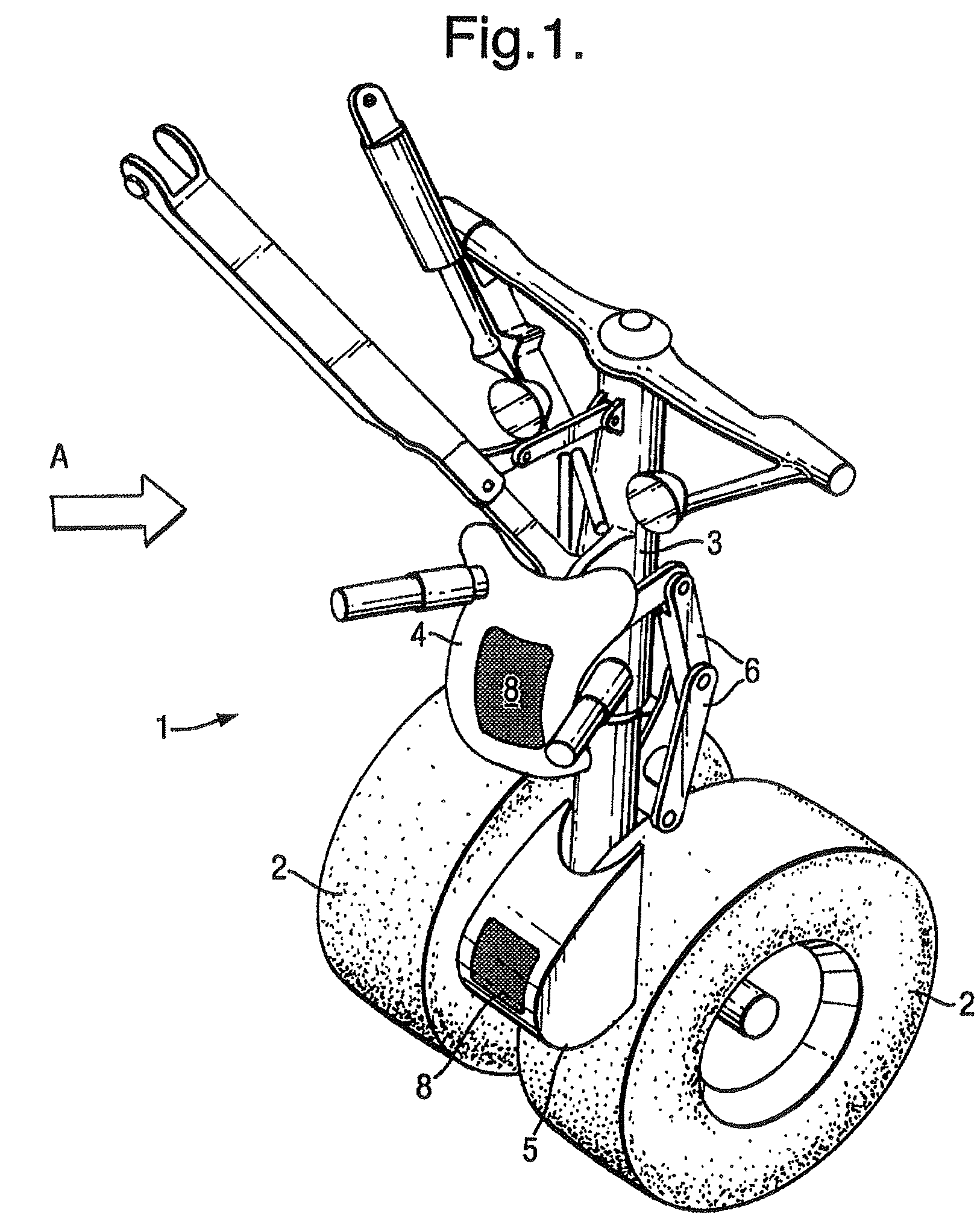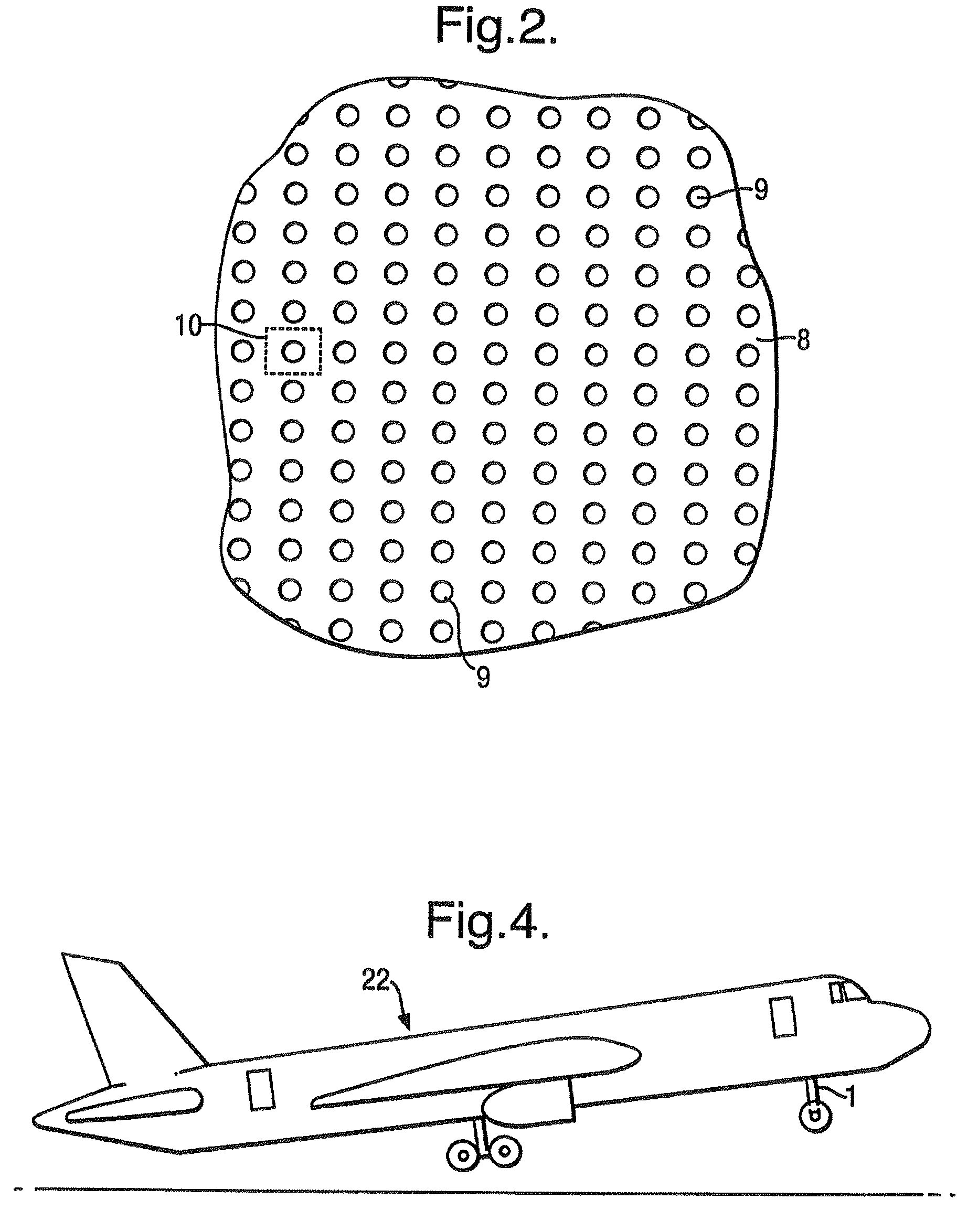Landing gear
a technology of landing gear and gear, which is applied in the direction of landing gear, aircraft components, aircraft control, etc., can solve the problems of eddy current(s), turbulent air flow that generates extra noise, and flow being created, so as to reduce disruption or inconvenience, and the effect of minimizing the noise generated by aircra
- Summary
- Abstract
- Description
- Claims
- Application Information
AI Technical Summary
Benefits of technology
Problems solved by technology
Method used
Image
Examples
first embodiment
[0054]FIG. 1 illustrates the invention concerning a nose landing gear 1. The nose landing gear 1 includes wheels 2 a central support column 3 (or leg) and an upper fairing 4 and a lower fairing 5. The nose gear 1 is shown in its deployed position during landing of an aircraft (not shown in FIG. 1) to which the nose landing gear 1 is attached. The direction of flow of air relative to the nose gear is indicated by arrow A which points to the right in FIG. 1, since the nose gear and aircraft are moving to the left.
[0055]The upper fairing 4 is positioned over the central support column 3 in a position that shields parts 6 of the landing structure that are associated with the steering of the nose gear wheels 2. The parts 6 that are shielded by the fairing include steering actuators (comprising rods, linkages and the like) that would if not shielded generate significant noise. The upper fairing 4 is attached to the gear 1 via steering actuator mounting brackets. The upper fairing 4 has re...
second embodiment
[0066]the invention is shown in FIG. 3, which shows a main landing gear 11 including wheels 2 and a central support column 3 (or leg). The gear 11 includes several fairings 12, 13, 14, 15. The main gear 11 is shown in its deployed position during landing of an aircraft (not shown in FIG. 3) to which the main landing gear 11 is attached. The direction of flow of air relative to the landing gear is indicated by arrow B which points to the left in FIG. 3, since the main landing gear and aircraft are moving to the right.
[0067]The fairings illustrated in FIG. 3 include an undertray fairing 12, an articulation-link fairing 13, a door / dragstay-closure fairing 14 and an upper side-stay fairing 15. Each fairing includes, in a manner similar to that of the fairings shown in FIG. 1, a perforated region 8 which covers a stagnation point or part of a stagnation line. Thus the principles behind and improvements provided by the arrangement of the fairings shown in FIG. 3 and the perforated regions...
fourth embodiment
[0114]In this fourth embodiment the noise-reducing mesh 212 is made from uncoated stainless steel, but other metals are suitable, such as brass, titanium or aluminium or alloys thereof. The mesh may alternatively be made from plastic, such as Nylon, or from composite material. The wire may be coated with a protective coating, such as a powder coating or paint. The use of a coating may also enable the porosity of the mesh to be reduced, by increasing the effective thickness of the wire. The mesh 212 is pre-formed to ensure a close fit to the support structure 214.
[0115]The gap size in the mesh 212 at its widest is about 5 mm, but in some regions the gap size is as low as 1 mm. Other gap sizes might also provide noise-reduction benefits. Gap sizes in the range of 0.1 mm to 2 mm would be preferable. The gap may however be 10 mm or larger. The gap sizes may be in the range of 0.2 mm to 12.5 mm. The gap size need not be uniform across the mesh 212. It may for example be preferable to hav...
PUM
 Login to View More
Login to View More Abstract
Description
Claims
Application Information
 Login to View More
Login to View More - R&D
- Intellectual Property
- Life Sciences
- Materials
- Tech Scout
- Unparalleled Data Quality
- Higher Quality Content
- 60% Fewer Hallucinations
Browse by: Latest US Patents, China's latest patents, Technical Efficacy Thesaurus, Application Domain, Technology Topic, Popular Technical Reports.
© 2025 PatSnap. All rights reserved.Legal|Privacy policy|Modern Slavery Act Transparency Statement|Sitemap|About US| Contact US: help@patsnap.com



